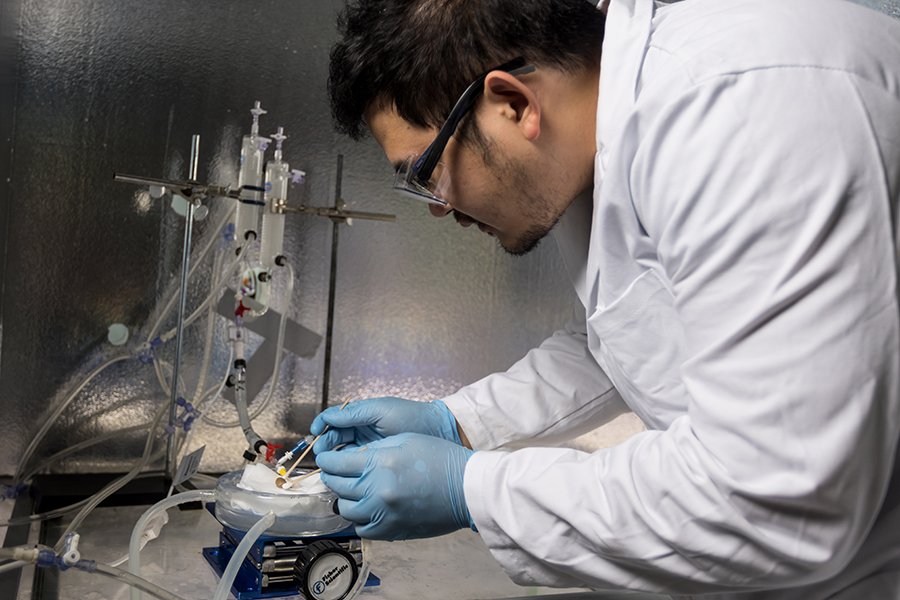Researchers perform first successful transplant of functional cryopreserved rat kidney

Unique preservation and rewarming process opens the door for future organ banking
MINNEAPOLIS / ST. PAUL (06/22/2023) — In a groundbreaking new study, engineers and medical researchers at the University of Minnesota Twin Cities have proven the life-saving potential of long-term organ preservation at ultra-low temperatures by successfully transplanting a rewarmed kidney in a rat and restoring full kidney function.
The research, published in Nature Communications, has the potential to save thousands of human lives by enabling long-term storage of organs for transplantation.
“This is the first time anyone has published a robust protocol for long-term storage, rewarming, and successful transplantation of a functional preserved organ in an animal,” said the study’s co-senior author John Bischof, a mechanical engineering professor and director of the University of Minnesota Institute for Engineering in Medicine. “All of our research over more than a decade and that of our colleagues in the field has shown that this process should work, then that it could work, but now we’ve shown that it actually does work.”
Currently, about 20% of kidneys donated for transplantation each year can’t be used, often because these organs cannot be kept on ice for longer than a few hours and do not reach recipients in time. Long-term cryopreservation methods like vitrification — cooling an organ in cryoprotective chemicals so fast it avoids forming ice — have been around for decades. However, the biggest problem has been the inability to rewarm them without major damage from ice or cracking.
The University of Minnesota team developed a specialized nanowarming process that warms the organ rapidly and uniformly from within rather than just at its surface. Their revolutionary method uses iron oxide nanoparticles dispersed throughout a cryoprotectant solution which is flushed through the organ’s blood vessels. The iron oxide nanoparticles act as tiny heaters throughout the organ when activated using noninvasive electromagnetic waves. Importantly, the iron oxide nanoparticles can be “washed out” after rewarming.
In this study, authored by postdoctoral researchers Zonghu Han (mechanical engineering) and Joseph Sushil Rao (surgery), the team showed that rat kidneys can be cryogenically stored for up to 100 days, successfully rewarmed, cleared of cryoprotective fluids and nanoparticles, and transplanted into rats. When the kidneys were transplanted, the five rat recipients were able to restore full kidney function within 30 days without additional interventions.
“During the first two to three weeks, the kidneys weren’t at full function, but by three weeks, they recovered. By one month, they were fully functioning kidneys that were completely indistinguishable from transplants of a fresh organ,” said the study’s co-senior author Erik Finger, a transplant surgeon and professor of surgery at the University of Minnesota Medical School.
Finger said that in transplants with humans, far more interventions would occur, including medicines and dialysis to assist the kidney for the weeks right after transplantation. None of this was done with the rats, and they were still able to survive the process with restoration of full kidney function.
“We have been working on this process for years to make sure everything was in place before we transplanted into a rat,” said Michael Etheridge, a principal research engineer in the University’s department of mechanical engineering. “Still, it is a very complicated process. We weren’t surprised this worked, but we weren’t going to be surprised if it didn’t work. I’m very proud of our team.”
Long-term organ banking could increase donor organ utilization, improve donor/recipient matching, enable immune tolerance protocols (reducing the need for immunosuppression drugs), and improve procedure preparation and scheduling. Importantly, while demonstrated in the kidney, this approach may one day be applied across transplant organs and also enable long-term storage of organs and tissue for biomedical and pharmacological research.
The researchers have shown that all aspects of this approach can be scaled to larger organs and will next look to demonstrate the process using pig kidneys. While it will take several years before a cryopreserved organ will be transplanted into humans, the team is confident that it could successfully be done in the future.
The research was primarily funded by the National Institutes of Health with additional support from the National Science Foundation and the Biostasis Research Institute which was funded in part through contributions from LifeGift, Nevada Donor Network, Lifesource, Donor Network West, and Lifebanc.
About the research team
In addition to Bischof, Han, Rao, Finger, and Etheridge, the University of Minnesota research team included Lakshya Gangwar (mechanical engineering), Bat-Erdene Namsrai (surgery), Jacqueline L. Pasek-Allen (mechanical engineering and biomedical engineering), Susan M. Wolf (Consortium on Law and Values in Health, Environment & the Life Sciences), and Timothy L. Pruett (surgery).
This research is part of a larger effort involving cryopreservation methods led by the University of Minnesota Twin Cities. In 2020, the University of Minnesota and Massachusetts General Hospital were awarded $26 million over five years from the National Science Foundation to create the Engineering Research Center (ERC) for Advanced Technologies for the Preservation of Biological Systems (ATP-Bio). ATP-Bio aims to achieve major bioengineering breakthroughs by developing and deploying the technology to stop biological time and biopreserve or cryopreserve numerous biological systems. ATP-Bio includes 30 senior personnel and more than 80 trainees from seven institutions across the U.S. and Canada.
